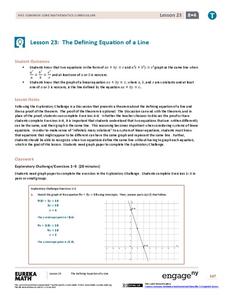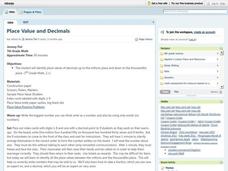Curated OER
Subtracting Whole Numbers
Second graders practice subtracting numbers by using a visual aide. In this number sense lesson, 2nd graders complete whole number subtraction problems by utilizing manipulative cubes to visualize the equation. Students...
Curated OER
Musical Whole Numbers
Fourth graders participate in a musical chair activity in which they practice identifying whole numbers. In this number sense lesson, 4th graders listen to a song and must get in the order of the number they hold on an index card...
Curated OER
Is Your Order Up or Down?
Students practice ordering numbers. In this number sense lesson, students collaborate to order whole numbers from greatest to least and least to greatest. Students also practice the concept by using educational software.
Curated OER
Guess That Sequence!
Learners analyze number sense by participating in a pattern identification activity. In this number sequence lesson, students examine several groups of numbers and identify the sequence in the group before adding on to it. Learners check...
Curated OER
Writing a Number Sentence
Third graders analyze word problems. In this number sentence lesson, 3rd graders evaluate word problems. Students create number sentences from word problems.
Curated OER
Racquetball With Math
Students explore physical education by participating in a game with their class. In this number sense lesson, students utilize their motor skills while performing a music version of racquetball. Students utilize math skills by...
Curated OER
Number and Operations: Webbing Our Way Through Numbers
Second graders explore estimation and place value. For this place value lesson, 2nd graders estimate and construct numbers while working with spider activities. Students use addition and subtraction to compare estimates. Resources and...
Virginia Department of Education
Modeling Division of Fractions
Provide a meaningful context for learning about the division of fractions with this upper-elementary math lesson. Presented with a simple, real-world problem, young mathematicians work in small groups to develop visual models...
EngageNY
The Defining Equation of a Line
They appear to be different, yet they are the same line. Part 24 out of 33 lessons provides a theorem about the relationships of coefficients of equivalent linear equations. Pupils use the theorem to determine whether two equations are...
EngageNY
Writing and Interpreting Inequality Statements Involving Rational Numbers
Statements often have multiple interpretations — but not these inequality statements. Scholars compare rational numbers and write inequality statements symbolically. The lesson includes problems that require comparing three numbers.
West Contra Costa Unified School District
Factoring Quadratic Expressions
Factor in different strategies in a lesson for factoring quadratics. Young mathematicians first create tables and area models to factor quadratic trinomials into two binomials by guess and check. Learners then investigate how they can...
Illustrative Mathematics
Sort and Count II
Capture the engagement of young mathematicians with this hands-on sorting activity. Given a bag of objects, students work independently sorting the items based on their physical attributes, counting to determine the size of each group....
Illustrative Mathematics
Making a Clock
Have a fun time teaching children to read analog clocks with this whole-group math activity. Using large sets of the numerals 1-12 and 0, 5, 10...55, the teacher creates a large clock on either the carpet or the white board, explaining...
Curated OER
Place Value and Decimals
Help your class investigate the concept of place values and decimals. They recognize place values to the thousandths place and solve different problems to demonstrate mastery. They practice writing and saying the numbers with the place...
Curated OER
Writing in Scientific Notation
Students discover number sense by completing a math worksheet. In this scientific notation lesson plan, students identify the purpose for writing in scientific notation and practice writing large numbers in scientific notation. Students...
Curated OER
Number: Index Notation
Middle schoolers explore the concept of index notation. In this square root and cube root lesson, students examine number patterns as they complete a worksheet that requires them to calculate roots.
Curated OER
The Human Body
Explore the human body through hands-on activities. Young learners will trace their bodies and place cut out body organs in the proper place, print patterns using cut fruit, sing songs about good nutrition, and use their five senses...
Curated OER
Math Lesson Plan: Put the Order in Ordinal Numbers
Students practice putting ordinal numbers in order. In this ordinal number lesson plan, students write ordinal numbers on index cards and use the cards to practice ordinal number order.
Curated OER
To Infinity: A Numbers Game
Students explore number values by participating in a class game. In this number sense instructional activity, students utilize dice, cards, and chess pieces to move their piece closer to the end of a number line, the point of infinity....
EngageNY
Logarithms—How Many Digits Do You Need?
Forget your ID number? Your pupils learn to use logarithms to determine the number of digits or characters necessary to create individual ID numbers for all members of a group.
EngageNY
The Long Division Algorithm
Two methods are always better than one! The eighth installment in this series asks pupils to convert decimals to fractions using two approaches. Individuals first use the more traditional approach of long division and then use reverse...
EngageNY
Exploiting the Connection to Trigonometry 2
The class checks to see if the formula for finding powers of a complex number works to find the roots too. Pupils review the previous day's work and graph on the polar grid. The discussion leads the class to think about...
EngageNY
Percent of a Quantity
Visualize methods of finding percents. Classmates find a percent of a quantity using two methods including a visual model in the 26th lesson in a series of 29. By the end of the lesson, scholars find percents given a part and the whole...
EngageNY
Networks and Matrix Arithmetic
Doubling a network or combining two networks is quick and easy when utilizing matrices. Learners continue the network example in the second lesson of this series. They practice adding, subtracting, and multiplying matrices by a scalar...























